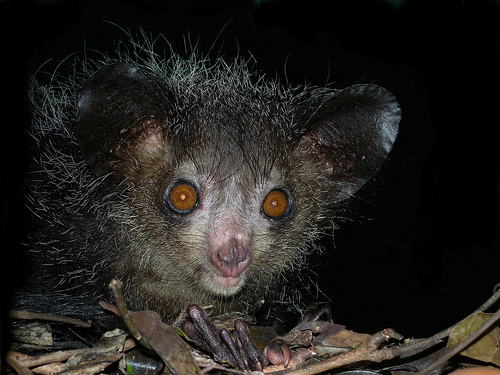What does the aye-aye remind you of?
- Aye-ayes are a species of primate, the largest extant nocturnal one on earth, and they are endemic to rainforests and other forest areas on the island of Madagascar, off the coast of Africa.
- The scientific name of the aye-aye is Daubentonia madagascariensis and it is a type of lemur from the family Daubentoniidae, of which it is the only living member.
- Aye-ayes grow to be 36 to 44 centimetres (14 to 17 inches) in height, with a tail of even greater length, and they weigh from 2 to 2.7 kilograms (4.4 to 6 pounds).
- The long fingers of aye-ayes are quite fragile and cannot hold much weight, with the third finger being particularly thin and used specifically for feeding purposes.
- The diet of an aye-aye consists primarily of fruit and grubs, the latter retrieved by tapping trees to find a cavity, then gnawing into the tree with its teeth and collecting prey using its third finger.
An Aye-Aye
Image courtesy of Frank Vassen/Flickr
- The colour of the hair of an aye-aye ranges from brown to black, with a partially white to grey head and orange or yellow eyes.
- Aye-ayes seldom descend to the forest floor, rather resting and foraging among the treetops; and they typically sleep in covered nests during the day, made from leaves and tree branches, though they will generally move to a different nest each day.
- Aye-ayes are listed as an endangered species, threatened by deforestation as well as locals killing the animal, as they believe the primate can cause misfortune.
- Sounds produced by aye-ayes include eerie screeches, hisses and the noise ‘hai-hai’; and it is thought that the mammal is named for the latter sound.
- The aye-aye has been – and still is- compared to a rodent primarily due to its teeth, and it was mistakenly classified as one for a significant time after its discovery.
Bibliography:
Aye-Aye, 2016, A-Z Animals, http://a-z-animals.com/animals/aye-aye-/
Aye-Aye, 2016, National Geographic, http://animals.nationalgeographic.com.au/animals/mammals/aye-aye/
Aye-Aye, 2016, Wikipedia, https://en.wikipedia.org/wiki/Aye-aye
Boucher, E, Daubentonia Madagascariensis, 2007, Animal Diversity Web, http://animaldiversity.org/accounts/Daubentonia_madagascariensis/







